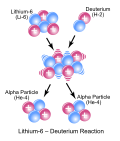 | Isobar (nuclide) (section Stability) (nuclides) of different chemical elements that have the same number of nucleons. Correspondingly, isobars differ in atomic number (or number of protons)... 6 KB (788 words) - 14:30, 22 November 2023 |
 | Beta decay (category Pages that use a deprecated format of the chem tags) binding energy. The binding energies of all existing nuclides form what is called the nuclear band or valley of stability. For either electron or positron... 58 KB (7,025 words) - 11:00, 14 April 2024 |
 | Isotope (section Nuclear properties and stability) of Nuclides – IAEA with isotope data. Annotated bibliography for isotopes from the Alsos Digital Library for Nuclear Issues The Valley of Stability (video)... 47 KB (5,822 words) - 00:49, 3 May 2024 |
 | Nuclear physics (redirect from History of nuclear physics) as the valley of stability. Stable nuclides lie along the bottom of this energy valley, while increasingly unstable nuclides lie up the valley walls,... 40 KB (4,760 words) - 10:09, 23 April 2024 |
 | Proton (redirect from Mass of proton) positive electric charge of +1 e (elementary charge). Its mass is slightly less than the mass of a neutron and 1,836 times the mass of an electron (the proton-to-electron... 65 KB (6,829 words) - 17:53, 29 April 2024 |
 | protons it contains. Alpha decay occurs in such nuclei as a means of increasing stability by reducing size. One curiosity is why alpha particles, helium... 19 KB (2,542 words) - 13:35, 20 March 2024 |
 | Stable nuclide (redirect from Band of stability) Radionuclide Stable isotope ratio Table of nuclides Valley of stability "DOE explains ... Isotopes". Department of Energy, United States. Archived from the original... 29 KB (3,356 words) - 14:52, 29 February 2024 |
 | Nuclide (section Nuclear properties and stability) information on abundance of stable nuclides) List of elements by stability of isotopes List of nuclides (sorted by half-life) Table of nuclides Alpha nuclide... 18 KB (1,698 words) - 11:52, 10 April 2024 |
 | of protons and neutrons (together known as nucleons) in an atomic nucleus. It is approximately equal to the atomic (also known as isotopic) mass of the... 8 KB (1,101 words) - 02:39, 15 April 2024 |
 | Beta-decay stable isobars (redirect from Line of beta-stability) use in 1965. This line lies along the bottom of the nuclear valley of stability. The line of beta stability can be defined mathematically by finding the... 29 KB (2,256 words) - 09:07, 6 May 2024 |
 | Gamma ray (section History of discovery) γ ), is a penetrating form of electromagnetic radiation arising from the radioactive decay of atomic nuclei. It consists of the shortest wavelength electromagnetic... 57 KB (7,068 words) - 14:27, 1 May 2024 |
 | Positron emission, beta plus decay, or β+ decay is a subtype of radioactive decay called beta decay, in which a proton inside a radionuclide nucleus is... 9 KB (1,122 words) - 10:56, 4 March 2024 |
 | isotones. Similarly, 36S, 37Cl, 38Ar, 39K, and 40Ca nuclei are all isotones of 20 because they all contain 20 neutrons. Despite its similarity to the Greek... 5 KB (582 words) - 08:53, 3 January 2024 |
 | fission is a dominant decay mode for superheavy elements, with nuclear stability generally falling as nuclear mass increases. It thus forms a practical... 18 KB (1,955 words) - 17:16, 10 April 2024 |
 | Oganesson (redirect from History of oganesson) D. N. (2008). "Search for long lived heaviest nuclei beyond the valley of stability". Physical Review C. 77 (4): 044603. arXiv:0802.3837. Bibcode:2008PhRvC... 63 KB (10,424 words) - 02:45, 5 May 2024 |
 | Nuclear fusion (category Pages that use a deprecated format of the chem tags) binding energy per nucleon. Fusion of nuclei lighter than these releases energy (an exothermic process), while the fusion of heavier nuclei results in energy... 91 KB (10,044 words) - 14:19, 8 May 2024 |
 | Primordial nuclide (section Stability) list of elements by stability of isotopes. For a complete list noting which of the "stable" 251 nuclides may be in some respect unstable, see list of nuclides... 24 KB (2,090 words) - 18:11, 18 April 2024 |
 | Atomic nucleus (redirect from Nucleus of an atom) show some evidence of stability. Observations of beta-stability of light nuclei outside closed shells indicate that nuclear stability is much more complex... 34 KB (3,994 words) - 07:45, 8 April 2024 |
 | Radioactive decay (redirect from Change of decay rate) containing unstable nuclei is considered radioactive. Three of the most common types of decay are alpha, beta, and gamma decay. The weak force is the... 96 KB (10,002 words) - 19:01, 7 May 2024 |
 | Ununennium (redirect from Isotopes of Ununennium) D. N. (2008). "Search for long lived heaviest nuclei beyond the valley of stability". Phys. Rev. C. 77 (4). 044603. arXiv:0802.3837. Bibcode:2008PhRvC... 42 KB (8,085 words) - 03:58, 23 April 2024 |
 | Nuclear fission (redirect from Splitting of the atom) P. K. Kuroda (1956). "On the Nuclear Physical Stability of the Uranium Minerals" (PDF). The Journal of Chemical Physics. 25 (4): 781. Bibcode:1956JChPh... 74 KB (9,613 words) - 19:52, 23 April 2024 |
 | 9 and 19 inclusive (though in those cases N = Z + 1 always allows for stability). Hydrogen-1 (N/Z ratio = 0) and helium-3 (N/Z ratio = 0.5) are the only... 4 KB (523 words) - 12:51, 29 January 2024 |
 | Decay product (category Pages that use a deprecated format of the chem tags) stable): U 238 ⟶ Th 234 ⏟ daughter of 238 U ⟶ Pa 234 m ⏟ granddaughter of 238 U ⟶ ⋯ ⟶ Pb 206 ⏞ decay products of 238 U {\displaystyle {\ce... 4 KB (428 words) - 23:29, 18 October 2022 |
 | Nuclear isomer (section Nuclei of nuclear isomers) fields created when the protons of the nucleus re-arrange in a different way. In nuclei that are far from stability in energy, even more decay modes... 30 KB (3,567 words) - 03:00, 3 May 2024 |
 | Internal conversion (section Example: decay of 203Hg) where an excited nucleus interacts electromagnetically with one of the orbital electrons of an atom. This causes the electron to be emitted (ejected) from... 12 KB (1,699 words) - 12:42, 1 May 2024 |


